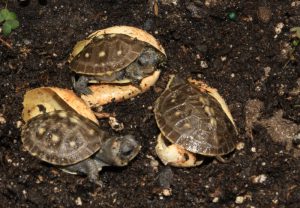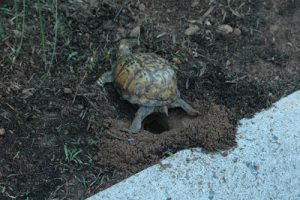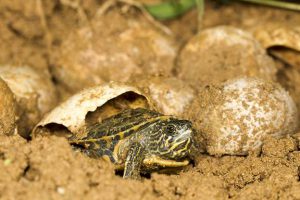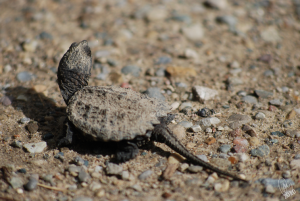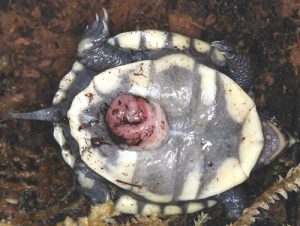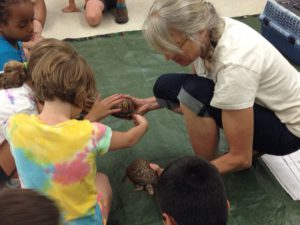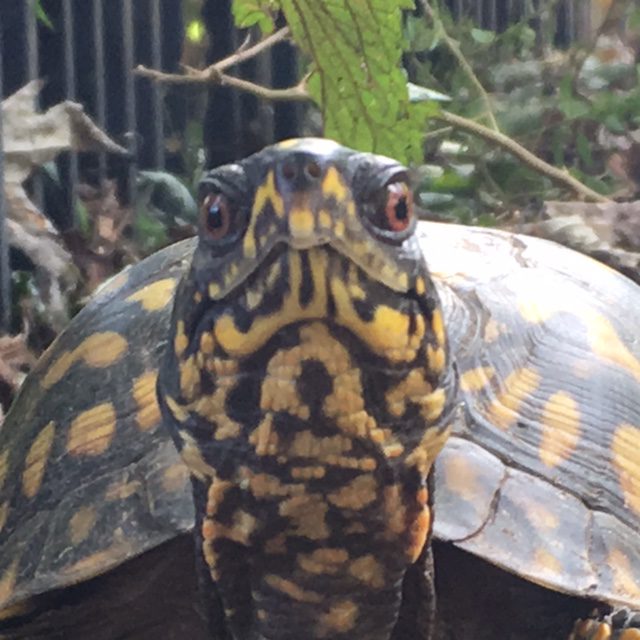Congratulations!
Box turtles are one of the oldest animals on our planet, and certainly one of the most unique and personable critters one can know.
I like to think of Box Turtles as having Super Powers. They evolved with our planet since the days of the Dinosaurs! Turtles have been here, on earth, for more then 200 million years. Think about that. That is a lot longer then humans have been around. Turtles were able to survive mass extinctions that wiped out most of the inhabitants on this planet, more than once!
How Did they do That?
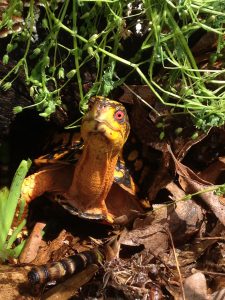
Super powers have served them well for thousands of years.. Will they survive humans?
Turtles are so connected to our earth and its temperature changes, perhaps this is one of the super powers that allowed reptiles to survive extinctions, the ability to dig in and wait out the in-hospitable climate of thousands of years ago.
Being reptiles, Box turtles are unique in that they are ectothermic. That means along with fish and amphibians, they are cold blooded, and cannot regulate their own body temperature. Reptiles body temperature fluctuates according to its surroundings.
Mother Nature has been taking care of our shelled friends for a very long time, and, well, turtles know how to be turtles. It is very difficult to replicate the exact conditions that mother nature has provided them all these years. Keeping your turtle inside, whether it be year round or just for the winter can be done, but it does take some research, some practice and quite a bit of supplies to do it right.
How hard is it to keep a box turtle as a pet?
Although Box turtles seem slow and unassuming, it is important to remember that they evolved to be perfectly suited to live in their specific habitat, and although it may seem that they would be an easy pet, That is indeed a false assumption.

Leaves help retain moisture, decompose by feeding worms and bugs, allow for natural foraging and create a natural floor for the eastern box turtle
Even if you keep your Box turtle in an enclosed pen outside, it is not the same as being wild. In the wild they have a territory that can span the space of 10 football fields, and being an opportunist, will eat almost anything organic, including dead things, rotten things and even poop. Certainly these are things you would not and should not feed your captive Box turtle. In the wild, box turtles are able to find a wide variety of berries, mushrooms, insects and all sort of things that we can hardly duplicate in captivity. So it is of utmost importance that your box turtle get a variety of foods including a good bit of protein. It is believed that up to 75% of a Box turtles diet in the wild consists of insects and protein sources, which allow calcium for growth of the all important shell. Captive Turtles kept outside or inside should be fed and monitored daily during the summer months. Many Box turtles enjoy soaking in their water bowls and often like to relieve themselves during their soak, making daily water cleaning a necessity and important for the health of your turtle. Summer feeding is also an important time for Box Turtles to store fat for winter hibernation.
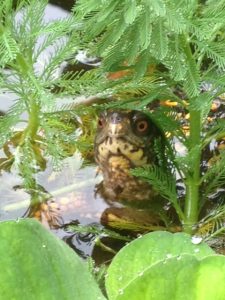
Box turtles enjoy a occasional soak, and often relieve themselves in the water.
Your outside turtle habitat will also need protection from unwanted guests and predators. In the wild, just about any predator will eat a small box turtle. Besides the normal predation of raccoons, skunks and the like, Crows can be especially dangerous if your habitat does not have enough plants to provide shelter. Even ants and mice can do damage to sleeping turtles. Many turtle keepers keep their outdoor turtle habitats covered with some sort of wire, and year-round maintenance and surveillance is required
If you plan to keep your new Box turtle indoors, You will want to supply him with as large of a habitat as you can. He will need clean water, and a special full spectrum sun light bulb. Your Box turtle will need humidity, a natural substrate that includes earth, leaves, bark, and plants native to his natural habitat (preferably ones he can eat). He will also need a place with deep shade (a hide) and he will need an extra heat source,so he can be kept at a suitable temperature. If possible this habitat should also have some worms and grubs for natural foraging.
If your Box turtle came from a place where winter is cold, then your box turtle most likely has hibernated or Brumated, as reptile people call it. Triggered by lack of heat and the decrease in the hours of daylight , Brumation is a state of dormancy in reptiles that is similar to hibernation in mammals, but differs in the metabolic processes involved, almost a chemical process.. Reptiles can go months in this state of torpor, but occasionally wake to drink water and then return to “sleep”.
, Brumation is a state of dormancy in reptiles that is similar to hibernation in mammals, but differs in the metabolic processes involved, almost a chemical process.. Reptiles can go months in this state of torpor, but occasionally wake to drink water and then return to “sleep”.
Does my turtle need to Hibernate / Brumate?
Now that you know what your turtle would do in its natural environment, it is up to you whether or not you let your shelled friend have a long winter nap. If you decide to keep a turtle as a pet it is your responsibility to provide the best possible care, whether you keep him inside or outside.
Some Turtle keepers believe that if your turtle would have hibernated / brumated in its natural
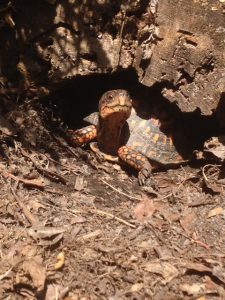
Hollow logs, cut in half make great hides year round.
habitat, they should be allowed to hibernate. Perhaps, due to the amazing ability to slow its metabolism during times of hibernation, the box turtle is able to live a good 100 years given the proper care. Still, many box turtle keepers will keep their turtles awake and inside all year, by maintaining heat, humidity, and daylight hours.
Many turtles will want to eat more before brumation time, but once the temperature drops on a regular basis, they will eat less and eventually refuse food, allowing their system to empty before their long winter nap.
There are a lot of ways to hibernate your turtle and a lot of how you go about it depends on your situation and available space. Turtle keepers are usually more than happy to give advise, and opinions, and are more then willing to help out our shelled friends.
I strongly recommend being connected with other box turtle enthusiasts on-line as soon as you decide to get a turtle. There are many turtle groups on Facebook and in turtle forums.
Be a Responsible Turtle Owner!
In the wild, Box Turtles are not in small boxes or glass containers and have a lot of room to find adequate food, shelter and sunshine. In our care we are responsible for every aspect of their needs and can’t let anything go with “In the wild” because it is NOT the same. Just because you keep your turtles in a small enclosed area outside does not mean they are wild or should be expected to survive as wild turtles do. If we decide to keep them as pets, whether indoors or out, we need to provide the best possible care that we can.
Please do your research before you venture into the responsibility of taking care of Turtles of any kind. Turtles do need our help! They are amazing and fascinating animals, and there is a lot of things we have yet to learn about them and their ability to survive. It is important that we share our love for these docile creatures with future generations, so they may survive the human race and our endless destruction of their earth.
Every turtle owner and potential owner needs to watch this short video at least once. Please watch it so you can see how important proper husbandry is for your new turtle.
The Monster You Made Me
The below articles were written by Sandy Barnett senior author of “Indoor Care of North American Box Turtles”. Sandy produced an educational CD on the natural history and conservation of the eastern box turtle (“Eastern Box Turtles, Disappearing Gems of the Forest”) for MATTS (Mid-Atlantic Turtle and Tortoise Society). It has been distributed to secondary schools, nature centers, and wildlife agencies with youth programs, and translated into German for distribution in German-speaking countries. Sandy also serves on the North American Box Turtle Conservation Committee. You can read more about Sandy Barnett here.

A young Eastern Box Turtle
Creating outdoor habitats
Creating indoor habitats
Box Turtle Diet
Diet recipe ingredients and instructions
Do you have a unique or different idea that makes taking care of your box turtles more efficient? I would love to hear about your turtle adventures! Please drop me a line, or ask me a question, lets see what we can figure out!
Shelley







